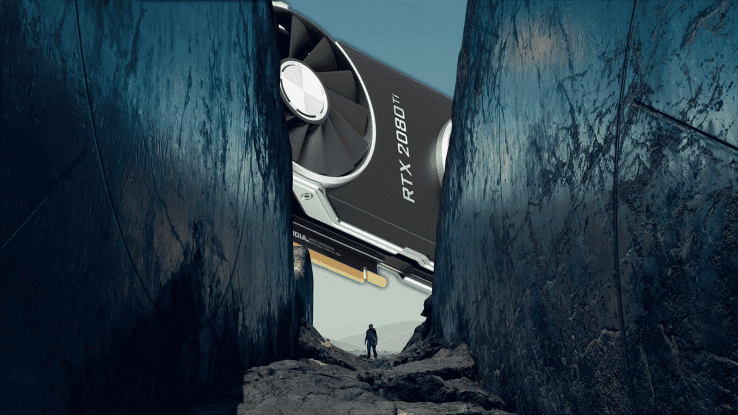Sapphire Pulse AMD Radeon RX 7900 XTX
Will Starfield Run on An RTX 2080 Ti
Starfield launches in less than 48 hours, is your RTX 2080 Ti up to the challenge? We do the math on Starfield’s performance

WePC is reader-supported. When you buy through links on our site, we may earn an affiliate commission. Prices subject to change. Learn more
Starfield is, without a doubt, one of the most anticipated games to launch from Bethesda this side of the Milky Way. With it, comes luscious planetscapes, immense nebulas, and enough space-combat to make even the most experienced womp-rat shooter weak at the knees. Nothing then, will be more jarring then, than if your tried and true gaming PC, complete with RTX 2080 Ti (or something equivalent), buckles at the first flash of a dogfight. Nope, no amount of combat experience can help when it comes to sub 20 fps performance.
Fortunately Starfield’s system requirements have now officially been announced, and although they don’t give much detail away in terms of performance metrics, they are, without a doubt quite subdued, and do allow us to make some educated guesses as to just how the RTX 2080 Ti might perform. The one clear thing you can spot in that list there, is that the recommended spec comes complete with an Nvidia RTX 2080 as standard, that’s the FE base version rather than our RTX 2080 Ti.
RTX 2080 Ti vs RTX 2080
On average (at least in our testing) the RTX 2080 Ti outperforms the RTX 2080 alone by around 28% on frame-rates at 4K, comfortably sitting above the 65fps mark in a mixture of titles. At 1440p it’s still a consistent delta, sitting pretty at around 24% or so, and that makes sense given the overall transistor count for the 2080 Ti is 36.76% higher than the RTX 2080.
On top of that you also get greater Ray Tracing performance with 107.6 TFLOPS of Tensor compute power versus the 2080’s 80.5 TFLOPS, and a healthy 3GB extra VRAM as well. Making the RTX 2080 Ti significantly superior on paper at least.
Early Starfield Driver Optimization
The big caveat to all of this is that, at least until Starfield officially launches, we have no way of truly knowing the exact performance these cards will provide. What is “Recommended” performance to Bethesda? Is that 4K 60fps? 1440p 100fps? Heck 1080p? We just don’t know at this moment in time. For a game with such a broad and beautiful universe like Starfield, it’s hard to even predict the overall performance.
On top of that, we’re likely to see a raft of graphics driver updates in the run-up to release. No doubt NVIDIA will release a driver on the 1st, to help smooth out the performance on its cards, (including the RTX 2080, and it’s TI brother), but we’ll likely see another by the 6th of September, and, depending on the popularity of Starfield, and general performance, possibly bug-fixes and rafts of updates after that.
What Performance Can You Expect in Starfield on The RTX 2080 Ti
Our best bet, at the current moment, the RTX 2080 Ti should perform admirably. It has 40-50% more at a hardware level than Starfield’s recommended RTX 2080, and packs a considerable punch, even today across a number of AAA titles. With some in-game tweaking at 4K it’s likely (and given the driver updates are sufficient) you should be able to hit 40–50 fps at least if not more. 1080p and 1440p, should be a shoe in, in comparison.
Of course, you could always upgrade, the RTX 2080 Ti is good, but it isn’t the best GPU for Starfield, that’s for sure. If nothing else, just be glad that PC gamer’s won’t be limited to 30 fps like our console brethren. Or at least, we don’t think so anyway.
What About AMD?
That’s the other angle here as well. Starfield is an AMD optimized title, meaning we’re likely to see better performance (both on an in-game level, and a driver level) from team red, particularly with its latest RX 7800 XT cards, which the company has specifically decided to launch on the exact same date as Starfield as well. Whether it (and its subsequent precursor cards like the RX 6800 XT) will out-compete the RTX 2080 Ti and Nvidia’s offerings remains to be seen. Although traditionally that has been the case, the gulf between NVIDIA and AMD’s latest and greatest, remains somewhat fluid when it comes to these partnership optimizations, even with ray tracing taken into account.
The only major downside to these brand partnerships is that we’re hearing rumors that there won’t be support for DLSS on launch because of it. One of the RTX 2080 Ti’s major advantages. Which although makes sense from a commercial standpoint, for gamers? Well, it just stings, certainly for a title that’s arguably, at least forgoing any major mishaps, likely to be game of the year.
Today’s best GPU deals
Sapphire Nitro+ AMD Radeon RX 7900 XTX Vapor-X Gaming Graphics Card
MSI Gaming GeForce RTX 4070 Ti 12GB GDRR6X
XFX Speedster SWFT319 Radeon RX 6800 Core Gaming Graphics Card
ZOTAC Gaming GeForce RTX 4070 Ti Trinity OC
MSI Gaming GeForce RTX 3090
GIGABYTE GeForce RTX 3060 Gaming OC
XFX Speedster MERC310 AMD Radeon RX 7900XTX Black Gaming Graphics Card
MSI Gaming GeForce RTX 4080
MSI Gaming GeForce RTX 4070 Ti